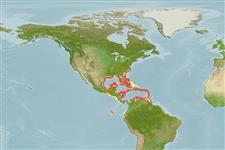Environment: milieu / climate zone / depth range / distribution range
Ecology
Marine; bathydemersal; depth range 30 - 400 m (Ref. 5222). Deep-water; 35°N - 3°S, 98°W - 58°W (Ref. 5222)
Western Atlantic: Bermuda, North Carolina (USA), Florida (USA), Gulf of Mexico, Bahamas, Cuba, Yucatan (Mexico), Jamaica, Puerto Rico, the Virgin Islands, and the Leeward islands to Trinidad. Eastern Pacific: Galapagos Islands.
Size / Weight / Age
Maturity: Lm ? range ? - ? cm
Max length : 160 cm TL male/unsexed; (Ref. 3244); 100.0 cm TL (female); max. published weight: 107.0 kg (Ref. 3244)
Dorsal spines (total): 11; Dorsal soft rays (total): 14 - 15; Anal spines: 3; Anal soft rays: 8 - 9. With 8 or 9 regular vertical darker brown bars on side. The only grouper in the Caribbean with a pattern of regular dark bars (Ref. 26938). Further distinguished by the following characteristics: head and body buff; blackish brown pelvic fins; prominent blackish brown maxillary streak on the cheek along upper edge of the maxilla; depth of body contained 2.4-2.9 times in SL; head length 2.3-2.5 times in SL; convex interorbital area; rounded preopercle angle, with enlarged serrae, 1-2 small serrae at lower edge, just in front of the angle; serrate interopercle and subopercle; posterior nostrils greatly enlarged, diameter is 4 or more times larger than anterior nostrils (Ref. 89707).
A solitary (Ref. 26340), deep-water species reported from 100-400 m; juveniles sometimes in water as shallow as 30 m. Feeds on fishes, crustaceans, and squids (Ref. 89707). Virtually nothing is known of the age, growth, and reproduction of this species. Marketed fresh.
Life cycle and mating behavior
Maturities | Reproduction | Spawnings | Egg(s) | Fecundities | Larvae
Craig, M.T. and P.A. Hastings, 2007. A molecular phylogeny of the groupers of the subfamily Epinephelinae (Serranidae) with revised classification of the epinephelini. Ichthyol. Res. 54:1-17. (Ref. 83414)
IUCN Red List Status (Ref. 130435)
Threat to humans
Harmless
Human uses
Fisheries: commercial; gamefish: yes
Tools
Special reports
Download XML
Internet sources
Estimates based on models
Preferred temperature (Ref.
123201): 16.8 - 26.1, mean 21.7 °C (based on 68 cells).
Phylogenetic diversity index (Ref.
82804): PD
50 = 0.5001 [Uniqueness, from 0.5 = low to 2.0 = high].
Bayesian length-weight: a=0.01349 (0.00612 - 0.02972), b=3.03 (2.86 - 3.20), in cm total length, based on LWR estimates for this Genus-body shape (Ref.
93245).
Trophic level (Ref.
69278): 4.6 ±0.0 se; based on diet studies.
Resilience (Ref.
120179): Very Low, minimum population doubling time more than 14 years (Preliminary K or Fecundity.).
Fishing Vulnerability (Ref.
59153): Very high vulnerability (90 of 100).
Nutrients (Ref.
124155): Calcium = 10.5 [5.1, 24.3] mg/100g; Iron = 0.287 [0.135, 0.621] mg/100g; Protein = 17.8 [15.9, 19.6] %; Omega3 = 0.342 [0.178, 0.655] g/100g; Selenium = 21 [9, 49] μg/100g; VitaminA = 8.34 [1.56, 44.48] μg/100g; Zinc = 0.266 [0.183, 0.408] mg/100g (wet weight);
